Sektionsleiter | Section Chair: Turhan Çetin (Gazi University, Ankara, Turkey)
| Internet-Zeitschrift für Kulturwissenschaften | 17. Nr. | September 2010 | |
| Sektion 1.6. | The Effects of Natural and Cultural Values on Tourism Sektionsleiter | Section Chair: Turhan Çetin (Gazi University, Ankara, Turkey) |
||
A new Touristic Value uncovered:
The Ancient City of Pompeiopolis (Taşköprü)
Turhan Çetin (Gazi University, Ankara, Turkey) [BIO]
Email: cetin.turhan@gmail.com
Abstract
Pompeiopolis ancient city is located in town of Taşköprü, in the province of Kastamonu (Turkey). According to historical records of the year 64 B.C., the Pontus King Mitridates and the Romans waged war north of Gökırmak Valley. The Romans won the battle, and settled down in this area. The roman commander Pompeius constructed a brand new city on Zımbıllı Hill and named it Pompeiopolis.
The ancient city was discovered by the French consul of Sinop, Pascal T. Fourcade in the years of 1802-1812. American and European archeologists claim that the city of Pompeiopolis is much bigger and richer than the ancient city of Ephesus in İzmir. The first excavations in the area were conducted in 1910. Which have revealed some columns and mosaic tile panels; however a devastating fire that broke out in 1927 in a nearby residential area had greatly destroyed the ruins. The governship of Kastamonu has saved all the conducted monuments throughout the years from 1955 until 2005 in the Kastamonu Archeological Museum. In 2006, under the supervision of Professor Dr. Latife Summerer from Munich University (Germany), the excavating in Pompeiopolis has begun again.
Like the ancient city of Ephesus, also Pompeiopolis was established by the Romans. The biggest difference between those two cities is, that Pompeiopolis was established as a brand new city and Ephesus was built up on an already existing city.
While the diggings at Pompeiopolis continue, the revealed artifacts and remnants should be protected and exhibited at establishments such as Taşköprü City Museum or Archeological Museum. The revealed monuments of Pompeiopolis ancient city should make the Black Sea a well known place in the world. With a good promotion of the ancient city and correct investments for touristic visitors, Pompeiopolis will be the highlight of the Black Sea region (like: Ephesus or Zeugma) in a short time and will take a good place for international tourism.
1. Introduction
Pompeiopolis ancient city was established near the north of Gökırmak River in the town of Taşköprü center in Kastamonu (Turkey) (Map 1). This ancient region is also called the Zımbıllı Hill. Here are limestone structures very common which were formed in the 3. Geological time. In the north of Zımbıllı Hills are the Yaralı Göz Mountains, an extension of the Küre Mountains located. At its south, are Saraycık Mountains also an extension of the Ilgaz Mountains located (Map 3). The Gökırmak River, which played a very important role at the establishment of Pompeiopolis, is one of the most important arms of the Kızılırmak River. It's sources are the Küre and Ilgaz Mountains. The Gökırmak River passes through Kastamonu and Taşköprü and joins with Kızılırmak near the town of Durağan.
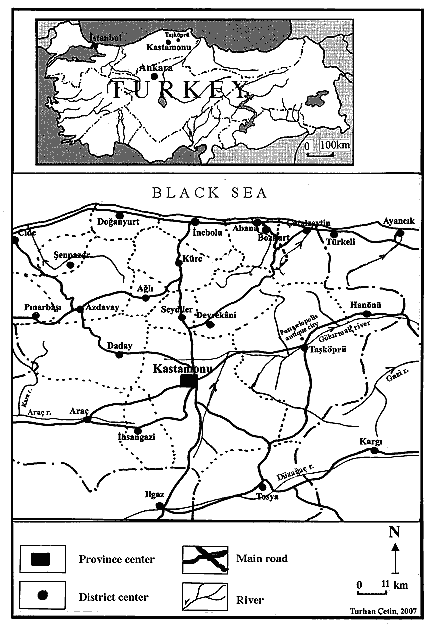
Map 1: Location Map of Pompeiopolis
Pompeiopolis ancient city is located at Kastamonu-Sinop road which passes through the town of Taşköprü. The distance from Taşköprü to Kastamonu is as 45 km, to Istanbul 570 km, to Ankara 280 km, to Samsun 270 km and to Sinop 152 km measured. The Gökırmak Valley, where the Pompeiopolis city was established at, has natural roads. That's why it was the most convenient region for settlements throughout all ages. The roads that pass through this valley; have always been, even in the ancient times and during the Roman times, of great importance for military and trading (Baran, 2002). Today the road starts from Vezirkopru, Duragan, Boyabat, Hanonu, Taşköprü, Kastamonu and comes to an end at Araç and Karabük, it is almost the same as the ancient road.
The population of Taşköprü was in 1530 as 1460 and in 1831 as 3766 determined. The population escalated from the 1935's 3945 to 2000's 16181 (Çetin and Karakuş, 2005). These data about the population show the importance of Taşköprü throughout all times.
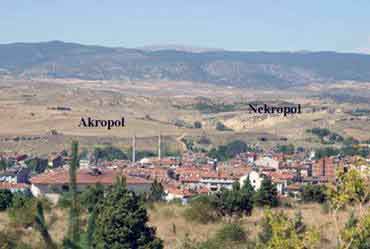
Photo 1: The necropolis and acropolis area at the Zımbıllı Hill, where Pompeiopolis was established
Since ancient settlements reflect the economic, social, cultural, physical, religious and political characteristic of ancient times, it is of high importance for tourism. In this period the cities were constructed into two sections, the Acropolis and the Necropolis. Acropolis literally means the edge of a town or a high city. For purposes of the defense, early settlers naturally chose elevated ground (Baran, 2002). In this castle the social (gathering place, parliament, theater, library etc.) and religious (temple, religious ceremonial places etc.) properties of the kingdom were located. Acropolis is also there to protect the king. Necropolis is a large cemetery or burial place of ancient cities. In ancient times deceased people were given more importance. At the burial of an important person or a king their belongings and jewels were buried with them. In the ancient city of Pompeiopolis there is an Acropolis and Necropolis present (Map 2).
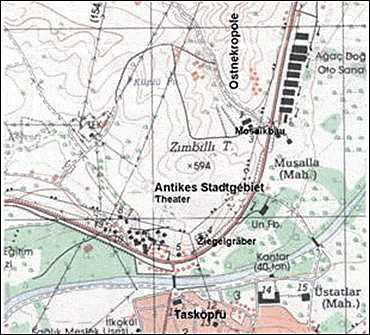
Map 2: Topografic Map of Pompeiopolis Antique City (Summerer, 2007)
The knowledge of the social and religious characteristics of ancient cities is one of the contributive subjects at the development of mankind .With each passing year today mankind inspired by these characteristics, has created much improved and much conscious structures. Today’s architects are being inspired by those architectural characteristics and those utilization spaces of the ancient cities.
Ancient cities are of higher importance for tourism, since they reflect the economic, social, physical, religious, military and political characteristics of their establishment era and the times after. The durability, the suitability for climate conditions and the right usage of light in ancient architecture makes mankind curious about how people thousands of years ago were able to built such amazing architecture without the facts of transportation utilities, construction techniques, technology and industry. That's why visits are made to see, to explore and to satisfy the curiosity about these characteristics.
2. History of Pompeiopolis Ancient City
As the results of the surface research of the history of Pompeiopolis, historians have determined a certain number of archeological foundlings from the Paleolithic era (600000-10000 B.C.). This circumstance is very important to clarify Taşköprü's and Karadeniz's history. Again in this order the determination of archeological foundlings from the Neolithic (B.C.8000-5500), Kalkolithic (B.C.5500-3000) and Early Bronze (B.C.3000-2500) era's show us that these ethos levels continued uninterrupted (Acar, 1995; Yaman, 1935).
In 2000 B.C. with the usage of writings, it can be observed that the information about Taşköprü and its surroundings has increased. The at that time period existing states of Pala and Tumana, whether with their writings or language took a very important place in Anatolia. Especially the official language of the Pala state was one of the third spoken languages in Anatolia (Yaman, 1935). According to Hittite writings at 2000-1200 B.C. Taşköprü and its surroundings go by the name "Dahara River Country". Also the acquired information from different tablets and writings shows that these areas got their name Paphlagonia in 1000 B.C. (Strabon, 1991; Yaman, 1935).
The Paphlagonia area contains Kastamonu, Sinop, Zonguldak, Cankırı, Bolu and Samsun provinces, the towns of Alaçam and Bafra and also Çorum provinces the towns of Kargı and Osmancık. The borders of this area are, in the west the city of Bartın, in the east Kızılırmak, in the south where Frigs and Galatia, known as Isık and Aydos Mountains, meet with the Kızılırmak, and the natural border of the Black Sea (Strabon, 1991; Gökoğlu, 1952). After the collapse of the Hittite Empire, Thrak Empire migrates intensely into Anatolia. After many circumstances these imperiums in order took the control over Taşköprü and surrounding: Frigs (B.C.800-700), Kimmer (B.C.700), Lydia (B.C.680-546), Persian (B.C.546-330), Helen and local kingdoms (B.C.330-64), Pontus Roman Empire (Yaman, 1935; Umar, 1988; Acar, 1995; Gökoğlu, 1952).
During the Roman Empire period, the region is under the control of the Pontus Empire. After the defeat of the Pontus Emperor Mithridates against the Roman General Lucullus in 730-720 B.C. The region fell into the leadership of the Roman Empire. Because of some disobedience in Lucullus' army, he has been called back to Rome and has been replaced by the former Consul General Pompeius (Photo 2). Another victory by Pompeius, also against King Mithridates made the Pontus Empire come to an end (Yaman, 1935). Pompeius came back for reconstruction of the region, started to build a brand new city in 64 B.C. and named the city Pompeiopolis, which means the city of Pompeius (Yaman, 1935; Umar, 1988; Acar, 1995; Gökoğlu, 1952).
Pompeiopolis is one of the rarest newly constructed cities in Anatolia, that's why it is considered important. It is of highly importance that academic excavations at this site will bring clarity to the practice of Roman hood in 1000 B.C. in northern Anatolia through the Romans, also the city planning and especially to the archeological styles during construction (Summerer, 2006).
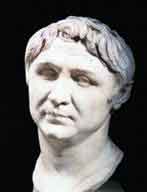
Photo 2: The headpiece of the city founder general Pompeiopolis' statue
Pompeiopolis has had its most powerful period under the ruler ship of Claudius Severius. At this period it was the centric city of Paphlagonia, it was mentioned as the sacred capital Metropolis Sebaste of Paphlagonia (Yaman, 1935; Acar, 1995). The "Pompeipoleiton met(ropoleiton), and Paphl(agonias)" coins were printed at this era (Photo 3).
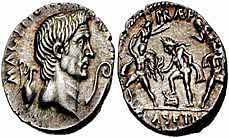
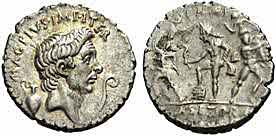
Photo 3: Pompeiopolis became the sacred capital of Paphlagonia during the period of Claudius Severius
and coins with Pompeipoleiton met(ropoleiton), Paphl(agonias) were published
All of the Paphlagonia cities have built up the Paphlagonia Senate between themselves and Pompeiopolis was chosen as place for Confederation meetings. The denotation of Pompeiopolis as Metropolis in the 200 and 300 A.C. could be explained as that it was the meeting center of the Paphlagonia confederation years ago (Umar, 1988; Baran, 2002).
When Christianity was spread in the medieval ages, the church made Pompeiopolis become the Episcopal center. In 536-553 A.C. it became the center of archbishop (Baran, 2002). The archbishop status of the city shows that it was again considered important.
The Seljuk ruler Alaaddin Keykubat's Commander Hüsamettin Çoban captured Kastamonu and surroundings in 1213 (Uzunçarşılı, 1973; Yücel, 1991; Yavuz, 2003; Yakupoğlu, 2006). After being conquered by the Turks, Pompeiopolis was abandoned and the town of Taşköprü was founded. The town got its name from the historical bridge that rises above the Gökırmak River.
In the first years of the Turkish Republic the Zımbıllı Hill stone mine started to operate and the ancient cities architecture was destroyed (www.turizmgazetesi.com, 23.10.2007). After the devastating fire in 1927, all of the architectural monuments above the ground like the ancient columns, the column heads, the stel, the architrave, the carved wall stones etc. were used as architectural fundament and as walls (www.taşkoprubelediyesi.com, 12.11.2007).
3. The Revealing of Pompeiopolis the Ancient City
The altitude of Zımbıllı Hill, the location of ancient Pompeiopolis is at 594 meters .The ancient city was first discovered by Pascal T. Fourcade the French consul of Sinop in 1802-1812 (Yaman, 1935; Çakır, 1994).
Between the years of 1955 through 2005, the museum of Kastamonu made periodic excavations at Zımbıllı Hill. All of the findings throughout these years, like the tomb heads, statues and Pedestals, column heads, the sarcophagus, coins and other architectural pieces are exhibited at the museum (Kastamonu İl Yıllığı, 1967).
Probably the highest one of the two hills, which is located at the ancient city area, was used as the acropolis. The surrounding plain area around those hills forms the residential area of Pompeiopolis (Map 2). Written sources and archeological findings prove that the city used to be the most civilized and the wealthiest city around the early emporium periods (Baran, 2002; Yaman, 1990). As a matter of fact, historical sources and excavation findings in the city like the governor’s villa, the administration building, the theater, the temples and the social and cultural buildings for the elite are a proof (Nasrullah Gazetesi, 2007).
It is believed that the territory in the east of the Zımbıllı Hill tumulus was the necropolis area (Map 2). The excavations in the past have conducted many findings such as baked soil also called urn, vases with lids or vase shaped cases in different sizes and materials like marble, stone, bronze and again rectangular tombs with shields made with baked soil. According to the explorations of the site, mosaic areas at the south and east foot of Zımbıllı hill tumulus were determined. The examination of the mosaics determined that cubic and triangular marbles, baked colored stones and glass was used. The first comprehensive and systematic research on Pompeiopolis Excavation Process, started on 03 August 2006 with the approval of the cabinet. This project is being performed under the supervision of Prof. Dr. Latife Summerer from the University of Munich (Germany) and other experts. The intention of the project is to determine the cultural remnants, to document them and to reveal the city structure (Summerer, 2006).
In 2006 in the first phase of the project Zımbıllı hill and its slope were measured with a theodolitle and a topographic map was published. The areas on the hill were intensively searched; its surface was investigated for wall, marble, ceramic, mosaic and tile remnants. At the north-east part of the hill two openings were dug to find indications about geographical layering and stages of city structure (Summerer, 2006). On the foot of Zımbıllı hill a second excavation, after the excavation of 1984, will give clarity to the architecture of the discovered roman mosaic villa (Photo 4).
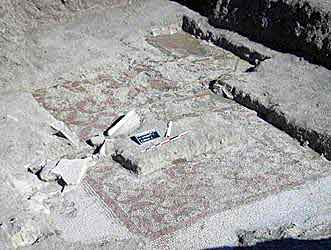
Photo 4: At the excavations discovered roman mosaic villa
The areas on the hill were intensively searched, wall remnants, and pieces of marble, ceramic tile were studied. After the resolution of surface and topographic research the starting point of the excavation was determined and 2 openings by the size of 5x5 m at the north of the hill were dug (Summerer, 2006).
At the first site wall remnants were revealed. Underneath of the wall debris of wall sequences and roof tiles as gatherings materials were found. According to supervisor Summerer's declaration these wall remains belong to the late roman period (Summerer, 2006). Besides some burnt down roof tiles, baked pieces of soil containers and numeral rusty nails were encountered (Photo 5).
At the second opening an unknown column was discovered. At this opening a wall remnant from the late roman period was also found. A garbage hole filled with cattle and pork bones and pieces of baked soil containers were sighted. A water passage, which is spread with baked soil tiles on the bottom, plasters coated sides and covered with unevenly stones, was also found. In both openings sand and pebble layers of 70-80 cm thickness were encountered. In addition 8 pieces of Roman bronze coins, rusty surfaced bronze, 170 pieces of marble, ceramic, tiles and many architectural pieces were found and put into storage to be further examined.
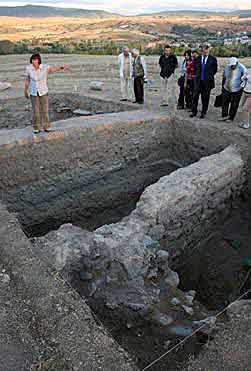
Photo 5: Revealed late roman walls from the 2006 excavation
At the eastern skirts of Zımbıllı hill tumulus, again another opening at the excavation place of 1984 was made. Here was an area 20 cm under the surface with wall with skirted broken mosaic revealed. Inside this with frame surrounded area, geometrical decorations made from red and white stones, sequences of ivy made of green stones, and designs of a cross flower can be seen. At the northern side of this mosaic area, a portrait of a woman, the so called "Goddess of Happiness" is located, she is wearing a crown with blue stones, her hair is covered with a net, she has big eyes and a bulky nose, she is holding a stick made out of blue stones in one hand, with the other hand she holding the medallion on her neck, she is wearing a dress made with yellow, red and white stones (Photo 6). The portrait is framed with colorful stones. At the bottom part of this portrait colorful decorations can be seen.

Photo 6: At the roman mosaic villa discovered portrait of the Goddess of Happiness
In the excavations in 2007 oil lamps, hair clips, a sewerage system, a bath, and an Augustus temple, possessing the name of the roman emperor Augustus were found. With extended geophysical studies the places of theater, the marketplace and the columned streets were determined (Nasrullah Gazetesi, 2007).
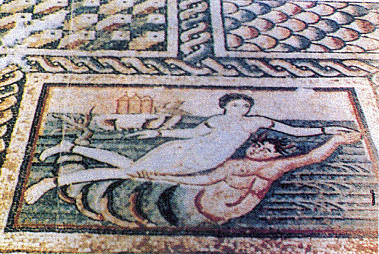
Photo 7: A discovery before the 2006 excavations, a mosaic piece with the design of Triton the God of the Sea
kidnapping a bathing woman in the lake
At the fire of 1927 most parts of the city were burnt down and the resident population has used the ancient remnants unconsciously at the reconstruction of the city. The ancient city was destroyed. And some of the remnants were even used at the constructions in the village (Photo 8).
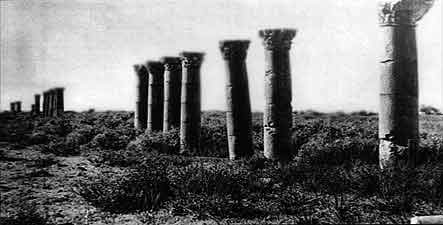
Photo 8: The in 1812 through Pascal T. Fourcade discovered columned street through is destroyed after the fire of 1927
All the remnants that were found in the years between 1955 until 2005 are being exhibited in the museum of Kastamonu. The remnants found in the excavations of 2006 under the supervision of Prof. Dr. Summerer are stored temporarily in the storages at the site (Photo 9).
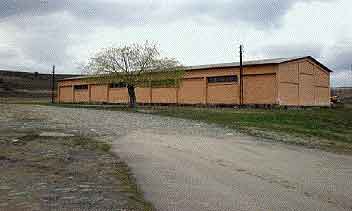
Photo 9: The protective storage of the ancient city remnants
The openings of Zımbıllı Hill are protected with a hardwood roof and onduline cover against natural elements and side effects such as rain, snow and wind.
The value, the mission, the promotion and the economical profits of Pompeiopolis the ancient city should be correctly adapted to the resident population. This mission should be transmitted by the governor, the head official of the district, the mayor, the museum director, the university and the media. The population should adopt this beneficial project for long term and should be supportive towards experts.
4. How Could Pompeiopolis the Ancient City become a Center for Tourism?
To be able to reveal all of Pompeiopolis, the ancient city, the completion of the excavation is necessary. The director of the project Prof. Dr. Latife Summerer reports that the completion could be possible in 2016 (Summerer, 2006).However the remnants from the excavation of 2006 and earlier times, could be exhibited in a restored historic building as a museum in the town. The exhibition would be informative about the characteristics of the ancient city to researchers, the resident population, the directors and tourists. At the same time this would speed up the promotion of the city in the world (Kastamonu Valiliği, 2006).
When the excavations are completed the ancient city could become an open air museum. Some sections of the open air museum, for example massive columns, watering passages, baths, gathering places, temples, palaces, villas and graves should be introduced by detail. Remnants that can't be exhibited in the open air museum due to harm through weather or security reasons could be exhibited in the town museum of Taşköprü. The remnants in the open museum and also in the town museum should be kept very protectively. As known, museums in Germany and Great Britain exhibit abducted historical remnants from Turkey. The right way for the universal heritage is to exhibit historical remnants at its origin.
The promotion is as important as the history of the natural and cultural possessions. Indeed everywhere in the world there exist many valuable cultural and historical possessions. However, if the promotion isn't done well, it will stay local and the world won't be informed about this fortune. Consequently the contribution to tourism is at a very low level.
The ministry of tourism and culture, township, private sector, civil organizations, researchers and residential population should work together at the promotion of ancient city Pompeiopolis. The ministry of tourism should publish brochures and booklets, and contribute these at consulates and at foreign expositions for better promotion. Township should be helpful at completion of the excavation, exhibition of the remnants, organization of a museum and services for domestic and international tourists. Other economic and social assistance should be offered. Private sector could be assistant with investments at accommodations, restaurants, transportation services and souvenirs to make the region become a touristic center. The cooperation of media and civil society organizations should also help to promote ancient city, the natural and cultural values, such as garlic, stone graves, tumulus', natural parks and recreational areas to the resident population and tourists.
Scientists and researchers who make research for the area should also actively assist to promote the natural and the cultural values all around the world. Especially history, archeology, tourism, geography and cultural researchers should announce their findings about the ancient city by publishing magazines and books. This will help the city to be known all around the world. If these researches are supported by ministry of tourism and local administrations, the promotion can be done in a wider range.
With a website containing scientific research about this subject, photographs, maps, transportation conditions and detailed archeological characteristics of the ancient city promotion could be quickened.
The important role of the local population can't be underrated. Because when tourists come to the region they deal with the local population during shopping, sightseeing, dining etc. That's why the attitude and behavior toward tourism and tourists is extremely important. If they have a positive attitude and behavior towards tourists, they will be pleased, spend their foreign currencies and make sure that friends also come to visit. But if the tourists are treated in a negative way, they wouldn't be satisfied, spent foreign currencies and wouldn't advise friends to visit the region. Local population will pay tribute to their own economical activation and the promotion by selling hand made carpets, mascots, reliefs and paintings about the region.
It is necessary that locals speak certain levels of a foreign language, especially English to be able to interact with foreigners and to progress commercial relations. Ministry of tourism, the governing official, town and civil organizations should give assistance. In this context, first of all, classes for English, then German, French, Russian, Arabic, Japanese, Chinese, Italian and Spanish should be assigned to teach the locals a foreign language. Especially the active population from the age of 15 to 45 year old should be thought a language.
In all touristic activities, the main necessity about attracting tourist to this area is, to offer a variety of transportation conditions and the ability of fast transportation qualities (Özgüç, 1994; Doğanay, 2001).
Since the excavations to reveal Pompeiopolis continue, there is still time for needed investments in short, middle and long term on account of transportation network. However the conditions of the transportation in the area are very tough. The Yaralı Göz Mountain which is located in the north from west- to east direction is the continuation of the Küre Mountain which runs evenly along the sea. Again, the Saraycık Mountain running along south from northeast and southwest direction is the continuation of the Ilgaz Mountains. The order of the two mountains restricts the ground, rail and sea transportation to the area (Map 3).
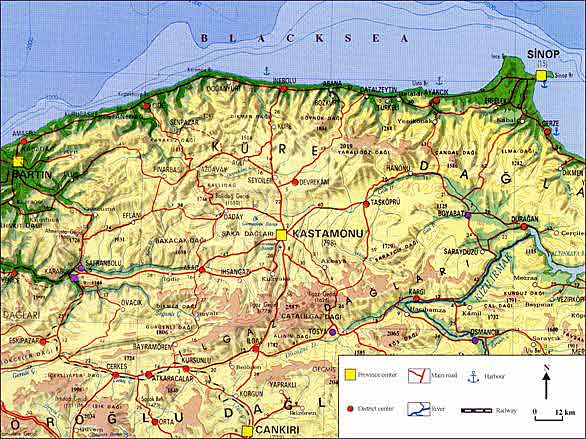
Map 3: Physical Map of Taşköprü and Surroundings
To make Pompeiopolis become a center of tourism, it is extremely important that the improvement and connection of the situation of roads, railroad air and sea transportation is present. To reach Pompeiopolis by seaway the closest way is the port of Ayancık which is located in the north of town of Taşköprü at the shores of the Black Sea (Map 3). Tourists who arrive at port of Ayancık can reach Pompeiopolis by roads. The road of Ayancık and Taşköprü of 82 km needs to be extended.
The second seaway to reach Pompeiopolis is İnebolu, which was one of the busiest and remained important Black Sea ports throughout history (Texier, 2002).
Tourists can come to İnebolu by seaway and reach Kastamonu and Taşköprü by roads. The length of the road between İnebolu and Taşköprü is 112 km. This route is compared with the other 30 km longer. However with the consideration of the more developed and bigger size of İnebolu port than the Ayancık port, the wideness of the İnebolu-Kastamonu-Taşköprü road compared to the other one, and the wish of Pompeiopolis tourists to visit the touristic places in Kastamonu, the second route gains much more importance.
When we consider the circumstances of air travel to the ancient city; Taşköprü and its surroundings with rough land shapes aren't very suitable for the construction of an airport. Direct flights to the region aren't possible. There is an airport at Kastamonu present but it is not operated. If visitors of the ancient city decide to prefer to come by airplane, they have to travel first to Ankara or Samsun and reach Taşköprü by road. The route of both roads to Taşköprü is approximately of three and a half hours distance. This causes loss of time for tourists and is less preferred. To ease the travel conditions for visitors of touristic sites like Pompeiopolis the ancient city, Safranbolu and Amasra, the today present but still unused airport should be operated as soon as possible and it should be suitable to international standards. On account of time, air transportation takes a major place in the tourism sector.
The above mentioned negative topographic conditions in the region prevent the development of a rail road transportation net (Map 3).The nearest train stations to the region are the in the west located county center Karabük and in the east the town of Havza (Samsun). To make the rail road transportation to the region possible, the railroad line from Karabuk-Kastamonu county center to Taşköprü-Havza needs to be built.
Today traveling with those transportation methods is very time consuming and difficult. Tourists, who want to get to the region, have to come to Ankara or Samsun by airplane and go by road to reach Taşköprü from there. Since Taşköprü on the other hand isn't located on one of the main roads, the existing road on the account of transportation remains insufficient. Approximately two thirds of Ankara-Taşköprü road consists of two lanes, the rest of one lane, and one part of it is very tight and dangerous. If Pompeiopolis the ancient city is considered together with Kastamonu, Safranbolu, Amasra as touristic centers, then all roads connecting the mentioned centers with each other should be constituted with double lanes. Nowadays, the transformation of big city roads and important roads into two lanes will ease the areas transportation characteristics. To make Pompeiopolis develop a touristic center, the Ankara- Çankiri-Ilgaz-Kastamonu-Taşköprü, the Bartın-Safranbolu-Kastamonu-Taşköprü and the Havza-Boyabat-Taşköprü roads need to be transformed into two lane roads.
The one of the most important facts of tourism is lodging services (Doğanay, 2001). when people travel to other places from where they live, with the intention of seeing, exploring, wondering, learning, being sportive, going to the beach and sea, being healthy, seeing the sun, visiting ancient cities, theaters, castles and historical architectures, museum and battle sites, lodging becomes more important. Especially in the last few years the dimensions of lodging have been expanded through the everything included system. These circumstances have made every tourist be able to decide according to his budget, whether to stay in a hotel, motel or boardinghouse. The cleaner, cheaper and comfortable lodging environments are provided; the number of tourists will increase in the same amount. Meanwhile the working staff in the tourism sector should perform good, honest and professional skills in language, behavior, work particularity, communication and assistance.
Like mentioned above, to make Pompeiopolis the ancient city become a touristic center, Hotels for accommodation in Taşköprü and Kastamonu should established suitably for tourists with different types of budgets. In addition, historical Taşköprü houses and historical Kastamonu mansions should be restored originally and should serve as boardinghouses and restaurants for tourism. The private sector and the local population should play an active role at the restoration of historical mansions as restaurants and the construction of hotels in the area. Again restaurants serving local foods such as Kuyu Kebap, Banduma and Meat Bread for tourists should be established.
5. Conclusion and Suggestions
The distance of the in the west of Black Sea region located ancient city of Pompeiopolis to Istanbul is as 570 km, to Ankara as 280 km, Samsun 270 km and Sinop as152 km measured. At the north of the ancient city, the Yaralı Göz Mountain and at the south of it the Saraycık Mountain is located. Since the territory of the region is very rough, difficulties in transportation are experienced. The region doesn't have connections such as rail ways, sea ways and air ways directly.
Pompeiopolis was built up in the Roman Empire and it's a settlement unit of carrying big amounts roman characteristics. The city is dominant at the fertile and rich agricultural land which surrounds the founded area. Again to possession of an important river like Gökırmak proves the wealth of the ancient city. Apparently through the findings, the ancient city isn't limited only with the Zımbıllı Hill but it also includes the center of the Taşköprü town. The history of the ancient city whereat of Taşköprü ranges back until the Phaleolitic period. This situation shows the age of the settlements at the Black sea region.
Like the ancient city Ephesus Pompeiopolis also was established by the Romans. But the most important characteristic that differs from Ephesus is, that it has been newly constructed .Ephesus on the other hand was constructed on an already existing city. The excavation project to reveal the ancient city of this importance is continued intensively since 2006. After good promotions and improvements of transportation conditions the ancient city will gain its place in tourism shortly.
While the archeological excavations of Pompeiopolis continue, the construction of a city museum or an archeological museum in Taşköprü for the exhibition and the protection of the remnants would be preferable. It is expected that the city after completion of the excavations will give clearance to the Hittite, Frig, Kimmer, Lydian, Persian, Roman and the East Roman periods. Being the only archeological excavation in the Black sea region proves its importance.
With the historical findings, Pompeiopolis, will become Black Sea's gateway to the world. If the promotion is done correctly and the necessary investments according touristic visits are made, Pompeiopolis also could shortly become like Ephesus and Zeugma, the symbol of the Black sea region and will take its deserved place in international tourism.
The suggestions below need to be taken into reconsideration to make Pompeiopolis to be known in international formats, to develop as an important touristic center, and it also would be profitable for Turkey and the local tourism.
References
1.6. The Effects of Natural and Cultural Values on Tourism
Sektionsgruppen | Section Groups| Groupes de sections
| Inhalt | Table of Contents | Contenu 17 Nr. |
Webmeister: Gerald Mach last change: 2010-09-08